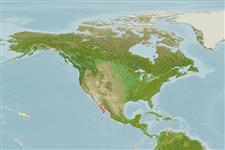>
Blenniiformes (Blennies) >
Chaenopsidae (Pike-, tube- and flagblennies)
Etymology: Acanthemblemaria: Greek, akantha = thorn + Greek, emblema, -atos, anything that is nailed, knocked in; also anything with bass or high relief (Ref. 45335); hastingsi: Named for Philip A. Hastings..
Environment: milieu / climate zone / depth range / distribution range
Ecologia
marinhas demersal; intervalo de profundidade 1 - 3 m (Ref. 84469). Tropical
Eastern Pacific: Gulf of California (limited to Mulegé to Cabo San Lucas along the Baja Peninsula and between Isla San Pedro Nolasco and Isla San Ignacio de Farallon along the Mexican continental mainland, Ref. 26771).
Tamanho / Peso / Idade
Maturity: Lm ? range ? - ? cm
Max length : 5.1 cm SL macho/indeterminado; (Ref. 84469); 4.0 cm SL (female)
Descrição suscinta
Morfologia | Morfometria
Espinhos dorsais (total): 23 - 25; Raios dorsais (total): 12-14; Espinhos anais 2; Vértebras: 42 - 44. This species is distinguished from its congeners in the Pacific, excluding its closest relatives, A. macrospilus and A. mangognatha, by having a single row of large brown blotches along its lateral midline and head spines that are pointed (vs. club-like or ridge-like). It differs from the 2 latter species by having a dark swath of melanophores on the dorsal fin in both males and females that highlights the bright orange coloration on that fin; presence of scattered melanophores reaching the tip of the lower jaw; and expression of orange as the primary bright head color. This species is further distinguishable from A. macrospilus by the 71 fixed mutations in COI and 20 fixed mutations in the D-loop region of its mitochondrial genome (Ref, 84469).
Ciclo de vida ou comportamento de acasalamento
Maturidade | Reprodução | Desova | Ovos | Fecundidade | Larvas
Lin, H.-C. and G.R. Galland, 2010. Molecular analysis of Acanthemblemaria macrospilus (Teleostei: Chaenopsidae) with descriptions of a new species from the Gulf of California, Mexico. Zootaxa 2525:51-62. (Ref. 84469)
Status na Lista Vermelha da UICN (Ref. 130435)
Ameaça para os humanos
Harmless
Uso pelos humanos
Mais informação
Nomes comunsSinônimosMetabolismoPredadoresEcotoxicologiaReproduçãoMaturidadeDesovaAgregação de desovaFecundidadeOvosDesenvolvimento dos ovos
Idade/TamanhoCrescimentoPeso-comprimentoComprimento-comprimentoFrequências de comprimentoMorfometriaMorfologiaLarvasDinâmica larvalRecrutamentoAbundânciaBRUVS
ReferênciasAquaculturaPerfil para aquaculturaEstirpesGenéticaElectrophoresesHereditariedadeDoençasProcessamentoNutrientsConversão de massa
ColaboradoresFotosStamps, Coins Misc.SonsCiguateraVelocidadeTipo de nataçãoÁrea branquialOtólitosCérebrosVisão
Ferramentas
Relatórios especiais
Baixar XML
Fontes da internet
Estimates based on models
Preferred temperature (Ref.
123201): 23.2 - 28.7, mean 25.6 °C (based on 138 cells).
Índice de diversidade filogenética (Ref.
82804): PD
50 = 0.5000 [Uniqueness, from 0.5 = low to 2.0 = high].
Bayesian length-weight: a=0.00457 (0.00183 - 0.01143), b=3.08 (2.86 - 3.30), in cm total length, based on LWR estimates for this (Sub)family-body shape (Ref.
93245).
Nível Trófico (Ref.
69278): 3.5 ±0.5 se; based on size and trophs of closest relatives
Fishing Vulnerability (Ref.
59153): Low vulnerability (10 of 100).
